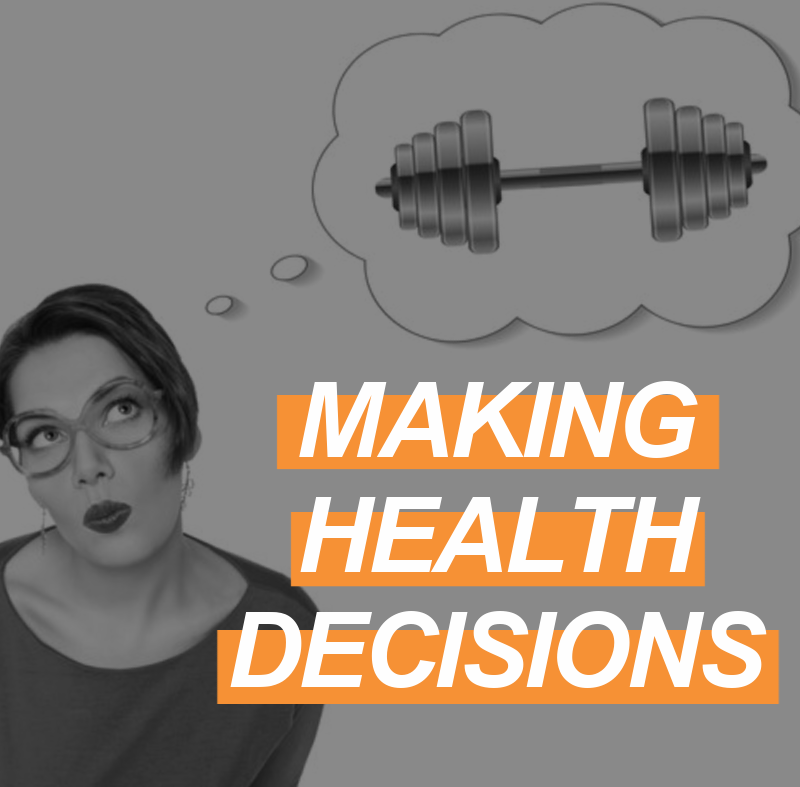
In the realm of fitness and wellness, much of our new clients’ judgment may rely on anecdotal evidence, celebrity marketing influence, short/long-term goals, and popular slogans that have woven their way into the cultural vernacular. Hard-to-break habits add to the dilemma. Read on to understand the collective feedback processes of the brain, and help your clients make better lifestyle decisions!
Choice Complexity
The complex decisions regarding lifestyle choices associated with food and exercise habits come packed with biological, social, and emotional variables. To avoid getting caught up in such tangled webs, many individuals seek out the simpler, more straightforward route, or what we might call “emotional choices”; in this arena, marketing experts and social media platforms exploit consumers by promising quick and easy fixes, regardless of their veracity. This inauthenticity contributes to the rapid decline of public health, hand in hand with skyrocketing healthcare costs.
Dual Decision Systems at Play
Seymour Epstein coined the term cognitive-experiential self-theory, describing two distinct cognitive processes which guide our decision-making behavior:
System 1: a quick, almost automatic emotional response, also called intuitive/experiential
System 2: an analytical/rational response that works logically and methodically, similar to how the brain solves a mathematical equation
System 1 governs the decisions often made as knee-jerk responses, such as which door to use when entering an office building, or where to sit in a waiting room. While these choices seem innocuous, some very important decisions — including those that influence our short-term and long-term health –often fall prey to System 1 thinking.
Today’s advertising industry knows just what words and images to use—for example, “Just Do It” or “No Pain, No Gain” — in order to tap into our System 1 decision-maker, where misled behaviors potentially turn into detrimental choices.
System 2 requires more time, as it harnesses intellectual lifestyle/health decisions. When attempting to devise a fitness program, or choosing among a myriad of eating plans for optimal health, the logistics of System 2 processing tend to yield a more personalized approach rather than the convenient “cookie-cutter” plan favored by System 1 thinking.
The Psychology of Decisions
The science of choice and decision-making encompasses a host of psychological processes. Research endeavors have included studies on attention span, information integration, and learning styles as well as the effects of goals and memories. The aforementioned Systems 1 and 2, defined by automatic versus deliberate processes, have led psychologists to consider the following:
- how and why we make certain mindful decisions
- how fitness/wellness professionals can help clients first comprehend how they made these decisions
- learn to then sidestep poor lifestyle choices in favor of healthier ones
Defining and Recognizing “Wellness”
Wellness, defined by some as an integration process above all, serves the all-important triad of mind-body-spirit. Personal trainers and lifestyle coaches may consider viewing wellness as an approach to life that enables clients to manifest the best possible version of themselves, given circumstances in their world at any given point in time. Including wellness in one’s daily lifestyle is best attained by being fluid and adaptable to changes.
Clients often confess to personal trainers that intellectually they know the best course of action required to achieve healthy goals, yet either choose not to act on it, or having tried it, eventually slide back into poor behaviors. Human nature leads us to struggle against two very important principles: self-regulation and habits.
Habits, Regulation, and Energy
Self-regulation allows individuals to act in accordance with their optimal value system. At the same time, the downside of self-regulation is the high demand of mental energy required to persevere in this commitment.
Habits, on the other hand, do not require much brain effort whatsoever. According to Charles Duhigg, author of the bestseller The Power of Habit: Why We Do What We Do in Life and Business, “Any behavior that can be reduced to a routine is one less behavior that we must spend time and energy consciously thinking about and deciding upon.”
The efficiency of habits, therefore, grants them power. Experts postulate that habits govern up to 40% of our daily behavior. As we move through life, then, both good and bad habits carry the ability to dictate (or at least influence) our health and wellness choices.
Once formed, habits weave their way into our brains, changing only when replaced with an even more compelling action. Rewiring our brains to move in a better direction ranks as one of the most difficult human tasks. Self-awareness and regulation can play a huge part in cultivating more positive lifestyle changes.
Recognizing Obstacles and Forging Successful Decisions
Success in health and fitness endeavors mirror that of any other undertaking in our lives. Let’s consider the commonly asked fitness question, “When is the best time for me to work out?” Personal trainers tend to respond to such an inquiry by telling clients to exercise when energy and/or motivation can work in their favor.
Self-awareness propels us to “act” when we feel the most productive. We must acknowledge, for example, that as a true early riser, one will undoubtedly fail at attempts to habitually exercise late at night. Knowing oneself also helps when deciding upon which mode of exercise to pursue. A thrill-seeker mountain bike enthusiast, for example, will never find success engaging in calming yoga or Pilates classes three times a week.
Self-awareness and choices enable us to make sound judgments regarding healthy decisions. Starting with the decision to commit a certain amount of time each week to forging a wellness-based lifestyle, we can begin to create healthier habits, purposefully strengthening them to function in our best interests. Armed with the knowledge and understanding of cognitive-experiential self-theory, fitness professionals can help clients in their quest to discover/create the best possible version of themselves.
References:
https://www.ncbi.nlm.nih.gov/pmc/articles/PMC6352612/
https://pubmed.ncbi.nlm.nih.gov/8014830/
https://en.wikipedia.org/wiki/Cognitive-experiential_self-theory
https://pubmed.ncbi.nlm.nih.gov/18798706/
https://www.ncbi.nlm.nih.gov/pmc/articles/PMC5508938/
https://www.ncbi.nlm.nih.gov/pmc/articles/PMC6600616/
https://openstax.org/books/principles-management/pages/2-2-how-the-brain-processes-information-to-make-decisions-reflective-and-reactive-systems
https://news.yale.edu/2019/06/25/how-brain-helps-us-make-good-decisions-and-bad-ones
https://www.brainfacts.org/archives/2011/the-neuroscience-of-decision-making
https://www.nature.com/articles/news.2008.751
https://www.frontiersin.org/articles/10.3389/fpubh.2019.00006/full
https://books.google.com/books?hl=en&lr=&id=O1MInVXd_aoC&oi=fnd&pg=PT9&ots=illXGN9x-H&sig=6smM6FF1eZuEjl_2JBDh_CuV92A#v=onepage&q&f=false







